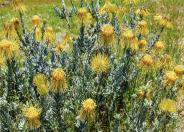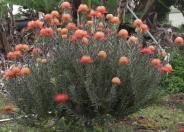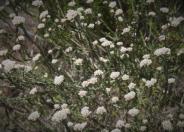
Common name:Yellow Rocket Pincushion
Botanical name:Leucospermum reflexum var. luteum
Yellow Rocket Pincushion is an attractive shrub that can reach 6-8' tall and 5-6' wide. The plant has a rounded habit with evergreen, gray green leaves held closely to the stems. Beautiful and unusual looking, pincushion looking flowers appear in late spring and bloom through summer. These yellow flowers droop during the bloom period. Flowers attract birds and bees. Great for flower arrangements. Plant in full sun in coastal gardens as it tolerates salt winds. It does well in sandy or loam soil that is neutral or acid in pH. This shrub does best with well draining soil. Established plants are drought tolerant, needing very little water in winter. A beautiful shrub for Mediterranean style gardens also.

Common name:Blanche Ito Nodding Pincushion
Botanical name:Leucospermum 'Blanche Ito'
Blanche Ito Pincushion is relatively new to the trade and so far has proven adaptable to most soils and garden conditions. Tip pruning from a young age and deadheading after flowers keeps this plant tidy and produces more blooms the following year. The 3-4" wide flowers are well displayed at the end of the foliage and are perfect for floral designs.

Common name:White Bristle Bush
Botanical name:Metalasia muricata
Metalasia muricata is a hardy, evergreen medium-sized shrub that is very variable in appearance and frost hardiness, depending on the region in which it occurs. This rounded, robust, sturdy shrub has fine silvery grey-green, needle-like foliage. The leaves can be smooth or woolly. In winter, the shrub is covered in honey-scented clusters of tiny white to pinky-purple flowers. The flowers attract many pollinating insects, and the seeds are eaten by birds. Can reach 13' tall. Does best in full sun with well draining, sandy, acidic soil. Excellent plant to include for coastal sand dune stabilization. Lovely shrub for textural and color contrast in the garden. Drought tolerant plant for water-wise gardens. Dried leaves are used as tea in Lesotho. It is useful as a tall filler in flower beds, providing grey-green foliage for color and textural contrast. As it is drought and wind tolerant, it can be used to screen lower plant beds from the wind.

Common name:Dekriet
Botanical name:Rhodocoma gigantea
This grass-like plant in the Restio family (Restionaceae) is an elegant large growing plant to 6 feet tall (to 9 in native habitat) with upright stems that arch over and droop under the weight of the cushions of very finely textured, bright green, lush foliage. Male and female plants have different flowers and each are an attractive feature from when they first emerge in winter until they mature in late spring. The male flowers are dark brown spikelets that hang down along tall stems to 6- 8 feet while the female flowers are lower by several feet and have pink hairy styles protruding from each brown spikelet. Plant in full sun to part shade. Irrigate in the spring when plants are in active growth. Hardy to at least 20° and we have a gardener in Oregon who tells us that it went through the very cold winter of 2008/2009, with temperatures down to at least 17° without damage but Suncrest Nursery reported damage to this species at 20° commenting that it "burned the foliage to a very attractive burnt orange color, but the plants recovered quickly the following spring with new shoots". A very showy container plant. Hails from the seaward side of Langeberg and Outeniqua and Tsitsikamma mountains in South Africa.

Common name:Gum leaved Conebush
Botanical name:Leucadendron eucalyptifolium
Large shrub 15-20' tall and 8-12' wide with yellow flush in winter-spring. Great screen or hedge plant for well drained, sandy soils in full sun. Excellent foliage for cut flowers. Frost tolerant to 22 degrees F and drought resistant shrub once established. Flowers resemble cone heads. Prefers low phosphorus soil. Prune in spring once the winter flowers have finished. Caterpillars and scale can be a problem; in humid conditions, there can be a problems with various fungal diseases. Evergreen leaves resemble eucalyptus leaves except they are brilliant chartreuse color. This evergreen shrub is wind tolerant but difficult to find in stores. Better luck by finding seeds to plant.

Common name:Blue sceptre; Blousuurkanol; Blouka
Botanical name:Aristea capitata
Aristea capitata is a clump-forming perennial with erect, leathery, strap-like, mid-green leaves arising from underground rhizomes. The spike-like flower stems can reach up to 6' tall. The flowers open in the morning and by the afternoon they start to wilt and close, with new flowers opening the next morning. Bloom period is spring through summer. The old flowering stems remain upright for months, turning a rich brown color. Aristea capitata does best planted in full sun with rich soil to which compost has been added. Water regularly, especially during the winter and spring. Lift and divide mature clumps after flowering, but only if really necessary. Make sure that the rhizomes do not dry out; re-plant immediately. Keep moist until the plants are established and show signs of new growth. This plant attracts bees and butterflies. Great for borders and containers. This plant does well in windy areas but is not frost tolerant. Roots are non-invasive.

Common name:Jackal-Tail Restio
Botanical name:Thamnochortus lucens
This perennial dwarf restio (family of grassy-looking South African plants) is a plant that will add some dazzle to your garden. The inflorescences are a shiny bronze color, guaranteed to catch your eye as you walk by. Thamnochortus lucens is a restio with an arching, tufted growth habit which remains rounded, compact and neat It is 1 ft to 2 ft tall and has a small base diameter and crown diameter. It has unbranched, smooth culms (stems) and side shoots often emerge from the nodes along the fertile culms as well as at the base of the plant. These small shoots become curled and tangle together but are sterile as they do not produce flowers or seeds. Restios occur as separate male and female plants (dioecious). This can make matching the sexes of the same species quite difficult. A good way to tell is to look at the sheaths found along the culms, male and female sheaths will always be the same for both plants. Thamnochortus lucens has persistent sheaths which are very long and tightly wrapped around the culm. At the base they are tan/brown, becoming lighter towards the margins. The upper part of the sheath becomes membranous and frays with age. In the garden, Thamnochortus lucens prefers a sunny spot with lots of air movement. It grows in a wide range of soils provided that it has good drainage. It does best in gravel, acidic soil. Add compost at planting time which should be early winter or at the start of the rainy season. The cooler weather and rain allow the plant to establish deep roots before the onset of the hot, dry summer season. Plant at other times of the year provided that the plant is well watered for the first two months. It is used to hot dry summers with minimal watering, although a more robust, lush plant will be achieved with regular watering. Looks great planted in large sweeps where wind moves the plants. Beautiful on slopes. Considered difficult to grow.
Designer: UC Berkeley
Photographer: Vicki Anderson
Maintain a two to four inch layer of mulch on the soil surface to reduce weeds, infiltrate rain water, and reduce compaction.
Attract, or buy beneficial insects such as ladybugs and lacewings to control pest outbreaks in your garden.